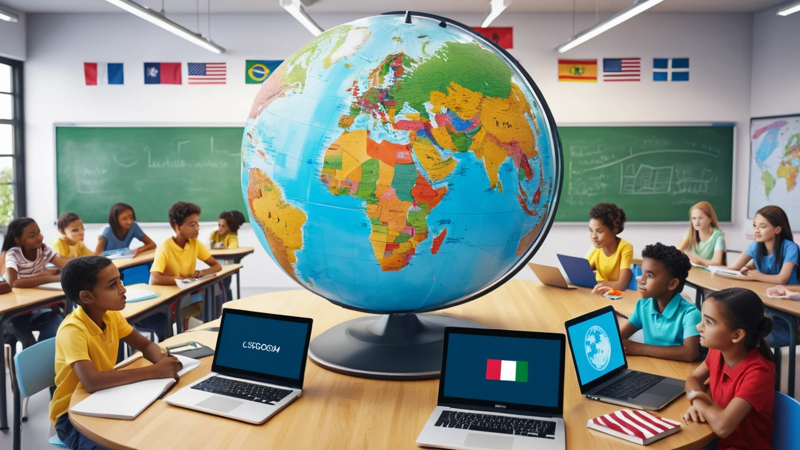Education
Education Reform Ideas From Around World: Powerful & Positive Insights

Education reform ideas from around world exploring innovative, equitable and successful models for change in schools and learning systems.
Education reform ideas from around the world showcase how nations are transforming schooling through inclusive policies, teacher investment, technology integration, and community-driven change to boost learning outcomes, equity, and relevance.
Education Reform Ideas From Around World 🌍
Have you ever wondered why some countries seem to get schooling right while others struggle for decades? The truth is, education reform isn’t a one-size-fits-all fix. It’s a mix of smart ideas, context, and consistent effort. Here’s how reformers around the globe are rewriting the rulebook — and what we can learn from them.
Let’s dive in.
Understanding The Search Intent
When someone searches for education reform ideas from around world, they’re looking for practical, real-world strategies used by various countries or education systems. They want what works, why it works, and how those ideas might apply elsewhere. So the article must include examples, context, evidence, comparisons, and clear take-aways.
Organizing For Clarity
I’ll guide you through multiple reform themes, each one pulled from global practice. You’ll find:
- What the idea is
- How different countries apply it
- Why it matters
- How you might adapt it
Let’s roll.
Emphasizing Early Childhood & Foundational Skills 👶
Starting strong is one of the most important education reform ideas from around the world. Many high-performing countries invest in early childhood education (ECE) and make foundational literacy and numeracy a priority. For instance, countries like Finland delay formal schooling until age 7, focusing on play and inquiry in early years.
Focusing on early years means children build the skills they need to thrive later. Rather than rushing ahead, they grow confident learners. By boosting early learning, reforms set the stage for better outcomes across the board.
Investing In Teacher Quality And Development 🎓
One of the core themes in global reform is investing in teachers. Countries that make teaching a respected profession—providing training, collaboration, and ongoing support—tend to see better student outcomes.
This means: better pay, opportunities for growth, peer learning, and digital skills development. When teachers feel valued, they are more motivated, more innovative, and more likely to help each student succeed.
Promoting Equity, Inclusion And Access For All ✊
Globally, reform efforts emphasize equity — ensuring all children, no matter their background, have access to quality schooling.
For example:
- Children with disabilities being included in mainstream classrooms
- Refugee children being integrated into national systems
- Girls’ education being supported in traditionally excluded groups
These are not just moral goals—they boost entire societies when everyone learns.
Embracing Digital Transformation And Technology Integration 💡
In a world that moves fast, education has to keep pace. Reform ideas from around the world increasingly include digital tools and connectivity such as e-learning platforms, blended learning, and teacher digital training.
But the key word here is digital equity. Simply having tech isn’t enough—students must have access and teachers must know how to use it. Done right, technology can personalize learning and open new opportunities.
Realigning Curriculum To Be Relevant And Future-Focused 🔄
Older systems often emphasize rote learning and narrow assessments. Modern reform acknowledges that students need critical thinking, collaboration, and creativity. In many countries, the curriculum is being updated to reflect 21st-century skills.
That means more project-based work, cross-disciplinary themes, and real-world problem solving. It’s about preparing learners not just to pass exams, but to thrive in changing jobs and societies.
Strengthening Governance, Leadership And Accountability 🏫
Research shows that the how of reform often matters more than the what. Many reforms fail because governance, stakeholder engagement, and clear delivery mechanisms are weak.
Good reform involves:
- Clear leadership and vision
- Engaged stakeholders (teachers, students, communities)
- Monitoring, data, and accountability
- Flexibility to adapt
These underpin sustainable change—not just quick fixes.
Promoting School Autonomy And Flexible Models 🏥
Around the world, reforms include giving schools more autonomy—within frameworks—so that local leaders and teachers can respond to their communities, innovate, and adapt. For example, allowing flexible curricula, school budgeting, and local decision-making.
This makes schooling more relevant and offers a sense of ownership to educators. It also encourages experimentation and learning from what works locally.
Integrating Non-Academic Skills: Social, Emotional, and Soft Skills 😊
Many reform initiatives recognize that learning isn’t just academic. Skills like emotional regulation, teamwork, resilience, and digital literacy are crucial. Some countries emphasize values and holistic development in early childhood.
By developing the whole child, education becomes more meaningful and better suited for life beyond subject tests.
Comparison of Reform Themes
| Reform Idea | What It Means | Why It Matters |
| Early childhood & foundational skills | Starting strong with literacy and numeracy | Builds long-term learning readiness |
| Teacher investment | Training, support, professional status | Teachers drive learning outcomes |
| Equity & inclusion | Access for all students | Reduces gaps, boosts society |
| Digital/tech integration | Tools + connectivity in learning | Prepares for modern world |
Using Data, Assessment And Feedback To Inform Reform 📊
Reform ideas from around the world frequently include better data systems and assessment models. The point isn’t just more tests, but smarter assessment: real feedback, diagnostics, and adaptive teaching.
This means:
- Identifying learning gaps early
- Teachers using real-time feedback
- Adjusting instruction
- Using data for policy-making
When done well, this helps tailor education to student needs rather than a ‘one-size-fits-all’ approach.
Encouraging Community And Stakeholder Engagement 🤝
Real education reform doesn’t happen in isolation. Engaging parents, communities, civil society, and employers — all of them are part of the picture.
When communities are involved:
- Reforms become more relevant
- Local context is respected
- Implementation is stronger
- People feel ownership
Promoting Lifelong Learning And Flexibility 🔁
More countries are recognizing that learning doesn’t stop at school. Reform ideas include lifelong learning frameworks, flexible pathways, adult education, and micro-credentials.
This means systems respond to learners at different points in life — not only children. It supports reskilling in a fast-changing job market.
Aligning Education With Economic And Labour Market Needs 💼
Education reform should connect with the skills employers need. Systems must equip students with the competencies to compete in today’s job markets.
That implies:
- Vocational and technical education
- Partnerships with industry
- Soft and digital skills emphasis
- Schools adapting to changing economies
When schooling connects to the real world, learners have better prospects.
Countries & Reform Examples
| Country | Reform Example | Key Take-Away |
| Finland | Delayed school start, no high-stakes testing | Quality over early pressure |
| Singapore | Holistic early learning, strong foundational focus | Balanced academics + values |
| Bangladesh | Elevating teacher status via career development | Teacher investment matters |
| Dominican Rep. | Minimum investment per child, transparent spending | Finance + accountability |
Ensuring Sustainable Funding And Resource Allocation 💰
Innovative reform ideas must be backed by resources. Consistent funding and efficient use of resources are the backbone of transformation.
Without sustainable funding:
- Reforms stall
- Schools lack materials, technology, and teacher training
- Gains are short-lived
So budgeting, transparency, and smart allocation are key.
Advocating For Flexible, Localised And Context-Specific Reform 🌱
One big lesson from global practices: what works in one country may not copy directly elsewhere. Reforms must be tailored to fit local culture, needs, and realities.
That means:
- Understanding community and resource differences
- Avoiding rigid adoption of foreign models
- Encouraging adaptation and experimentation
Fostering Innovation, Pilot Projects And Scaling What Works 🚀
Reform ideas from around the world also highlight the need for innovation – pilot programs, experiments, and scaling up effective models.
Key steps:
- Pilot new ideas
- Evaluate and refine
- Scale the ones that work
- Discard or adapt the ones that don’t
This approach minimizes risk and fosters continual improvement.
Emphasizing Global Collaboration And Cross-Learning 🌐
Finally, reform needs to look beyond borders. Countries, regions, and institutions learn from one another. Sharing insights, adapting, and localizing global ideas helps accelerate reform.
The world is our learning lab, and collaboration fuels progress.
Essential Checklist for Education Reform
| Checklist Item | Questions to Ask |
| Teacher capacity & training | Are teachers supported and developed professionally? |
| Equity & access | Are all students included, regardless of background? |
| Curriculum relevance | Does the curriculum match real world and future skills? |
| Governance & leadership | Is there clear vision, stakeholder buy-in, accountability? |
| Funding & resources | Are budgets sustainable and resources aligned effectively? |
| Innovation & measurement | Are pilots tested and data used for improvement? |
Key Takeaways & How To Apply These Ideas
You’ve seen a wide range of education reform ideas from around the world. Let’s recap:
- Start early: foundational skills matter.
- Teachers are at the heart of change.
- Equity and inclusion make education meaningful for all.
- Tech and digital tools need access and training.
- Curriculum must be relevant and future-oriented.
- Governance, leadership, and data drive success.
- Local context and adaptation are critical.
- Innovation and collaboration speed progress.
If you’re in policy, school leadership, or simply passionate about education, you can adapt these ideas:
- Pick 1-2 reform levers your context needs most.
- Mobilize the community and listen to learners.
- Allocate resources smartly and monitor outcomes.
- Start small, learn fast, scale thoughtfully.
Change is possible — and some of the world’s best ideas are ready for you to adapt.
FAQs
What are successful global education reform strategies?
Successful strategies include investing in teachers, ensuring equity, using data for feedback, updating curricula, and giving schools autonomy. Many countries combine these for better outcomes.
How can developing countries apply education reform ideas from around the world?
Start with context: identify the biggest gaps such as access, teacher quality, and funding. Choose simple, scalable reforms like teacher training or inclusive policy, pilot them, and expand proven ideas.
Which countries lead in innovative school system reform ideas?
Countries such as Finland, Singapore, and South Korea are often cited for leading reform ideas—they focus on teacher quality, holistic learning, student well-being, and efficient systems.
Why does education reform often fail even with good ideas?
Because implementation falters: governance is weak, stakeholder buy-in is missing, sustainability isn’t ensured, and local context gets ignored. Successful reform requires strong delivery and community trust.
What role does technology play in education reform ideas from around the world?
Technology enables access, personalized learning, and digital literacy. But it’s not a magic fix—it must be paired with teacher training, equitable access, and purposeful use to make a real impact.






